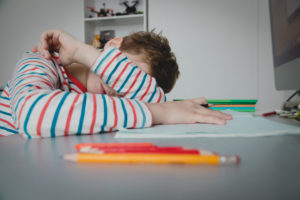Some of you reading this blog may not be familiar with the term sensory processing so here is a brief introduction.
You are here on this site most likely because you care about a child in your life.
As an occupational therapist focusing on sensory processing, I see many kids in the clinic I work in. Some of those kids are uncoordinated, some have trouble understanding spoken directions, or can’t identify letters of the alphabet among other struggles. Sensory processing plays a role in all of these difficulties.
Have you ever been in a room where the clock was ticking so loud that you could not focus? Or, have you worn clothing that rubbed your skin in a way that was impossible to ignore? How easy is it for you to find your way around a room in dim light?

Children’s ability to process the information provided by their senses will determine the quality of their life. If one of their senses is not delivering accurate information OR their bodies do not know what to do with this information, they will have more difficulties than their peers.
How we function emotionally and physically is influenced by how we feel in our bodies. Jean Ayres, a pioneer in children’s sensory processing studies, was one of the first people to notice that there was more to a child’s difficulties than what most doctors were measuring. She argued that unlike a broken bone, sensory processing difficulties can be less obvious but still just as impactful to how someone functions.
The good news is that because children’s brains are rapidly developing, they are more adaptable. For example, when younger people have brain injuries their outcomes of recovery are often much better than those of older adults. This is because young adults have more neural plasticity.
A Plastic Brain?
Neuroplasticity is a concept that describes a brain’s ability to change and adapt. Don’t worry though, neuroplasticity doesn’t go away for adults entirely!
As you learn about your child, you may have a few “a-ha” moments about yourself too. It has certainly happened to me when learning about the body and its sensory processing.
For example, I realize now that my difficulties with body awareness and poor auditory (sound) processing are the reason why I learned new movements slowly. At school, I often needed my classmates to tell me what the teacher had just said, even though my hearing was always tested as fine.
These days I have more compassion for myself and my tendency to break cups by misjudging where the counter is or putting the cup down with too much force.
My social skills often compensated for what was lacking. I know many kids make subtle adaptations and therefore their difficulties are hard to notice at first.
Signs of difficulties with sensory processing may include:
– Relying on vision more than other senses and needing demonstration for instructions.
– Constantly touching or bumping into things to get more body awareness.
– Spinning, running or rocking to get more information about movement.
– Excessive chewing on shirt sleeves.
– Squeezing their own bodies, hugging others tightly.
Personally, I learned to adapt to my needs by sitting on a therapy ball in grad school and making a standing desk with boxes. This didn’t go unnoticed, however, with a person commenting once that to them it seemed like I was always stretching.
How does the sensory system work?
The Flow of Sensory Processing:
1. Sensory input: When something touches your skin, that is a sensory input. This is picked up by nerve endings that tell other nerves what is happening. Your body communicates with itself using nerve cells that send messages to each other. This information usually travels to the spinal cord and brain.
There are the 5 senses we often hear about: sight, sound, taste, touch, smell. The ones you may not know as much about are proprioception (body awareness), vestibular (movement awareness) and interoception (internal senses such as hunger).
2. Sensory processing: Organizing the messages caused by the sensory input. The above-mentioned Jean Ayres, described sensory integration as “the organization of sensation for use.” For example, before you go to scratch an itch caused by something that touched your skin, your body must determine:
– How much force to use.
– What direction to move your hand.
– How far to move.
Most of this happens without us needing to think about it!
3. Adaptive response: Defined as “purposeful, goal-directed response to a sensory experience” by Ayres.
For example, the actual motion of moving to scratch your nose.
In summary: Sensory input -> Sensory processing -> Adaptive response
There can be breakdowns at any one of these stages that causes ripple effects on the child’s ability to function.
If you’ve read this far you may now be thinking: “Great, but now what do I DO about these difficulties?” Answers to this question will be coming up in my next blog posts. Those will focus on the somatosensory system:
1. Proprioception (body position/body awareness) processing
2. Tactile(touch) processing
This system creates the foundation for children needed to feel comfortable and confident in their own bodies.

References
Ayres, A. J. (1972). Sensory Integration and Learning Disorders. Los Angeles; Western Psychological Services.

